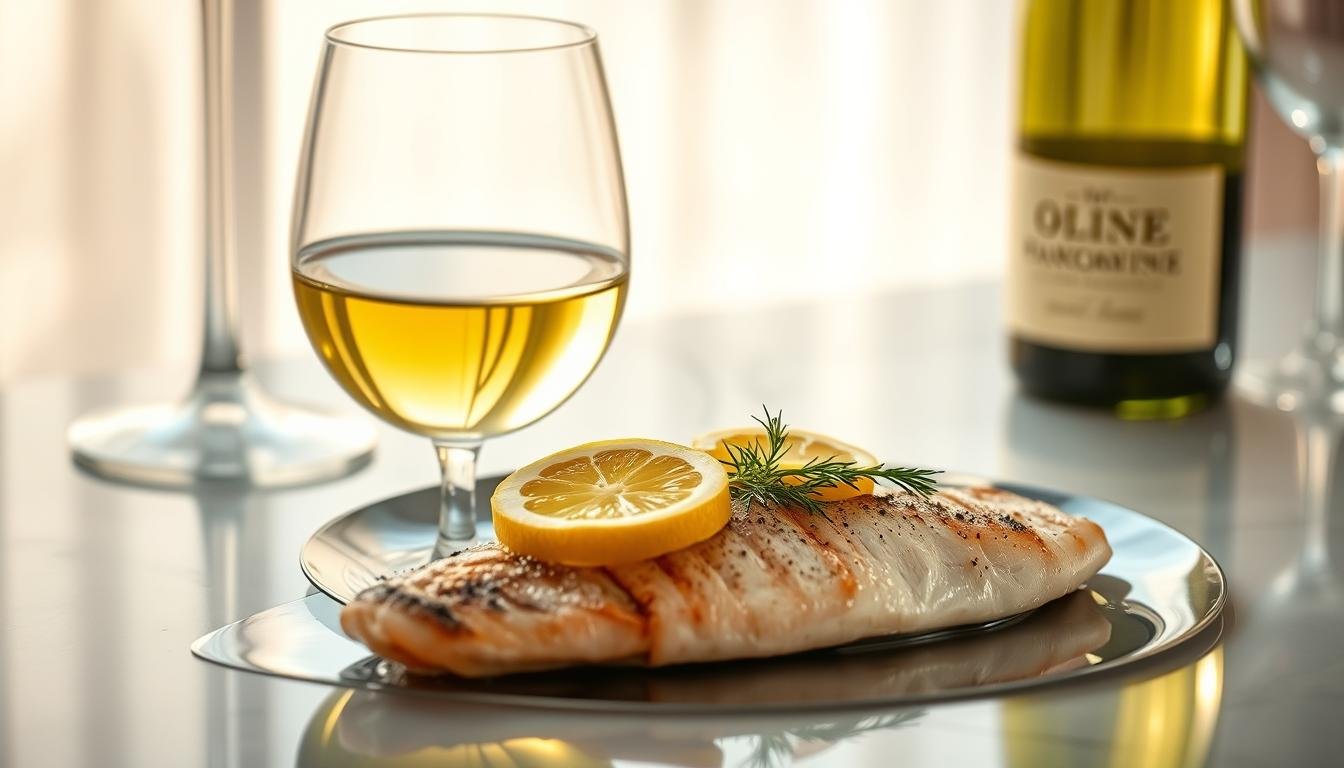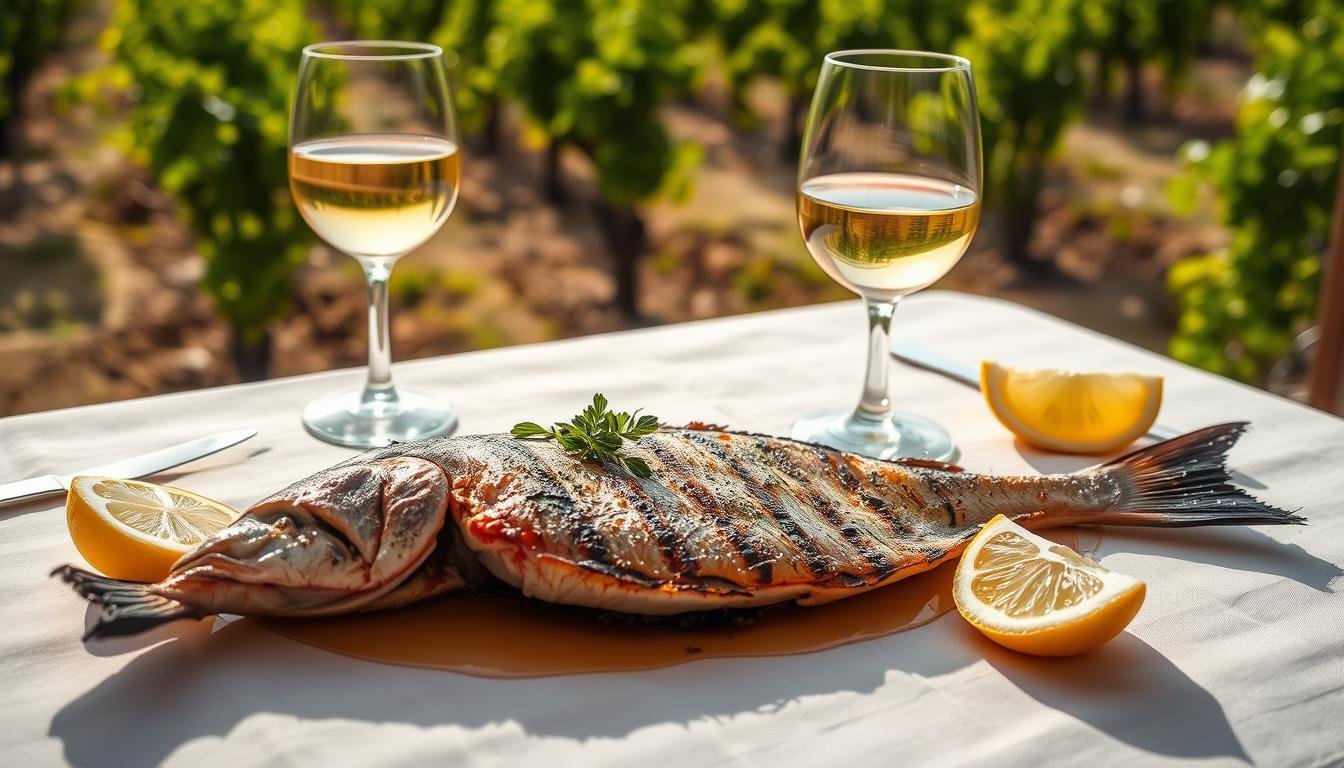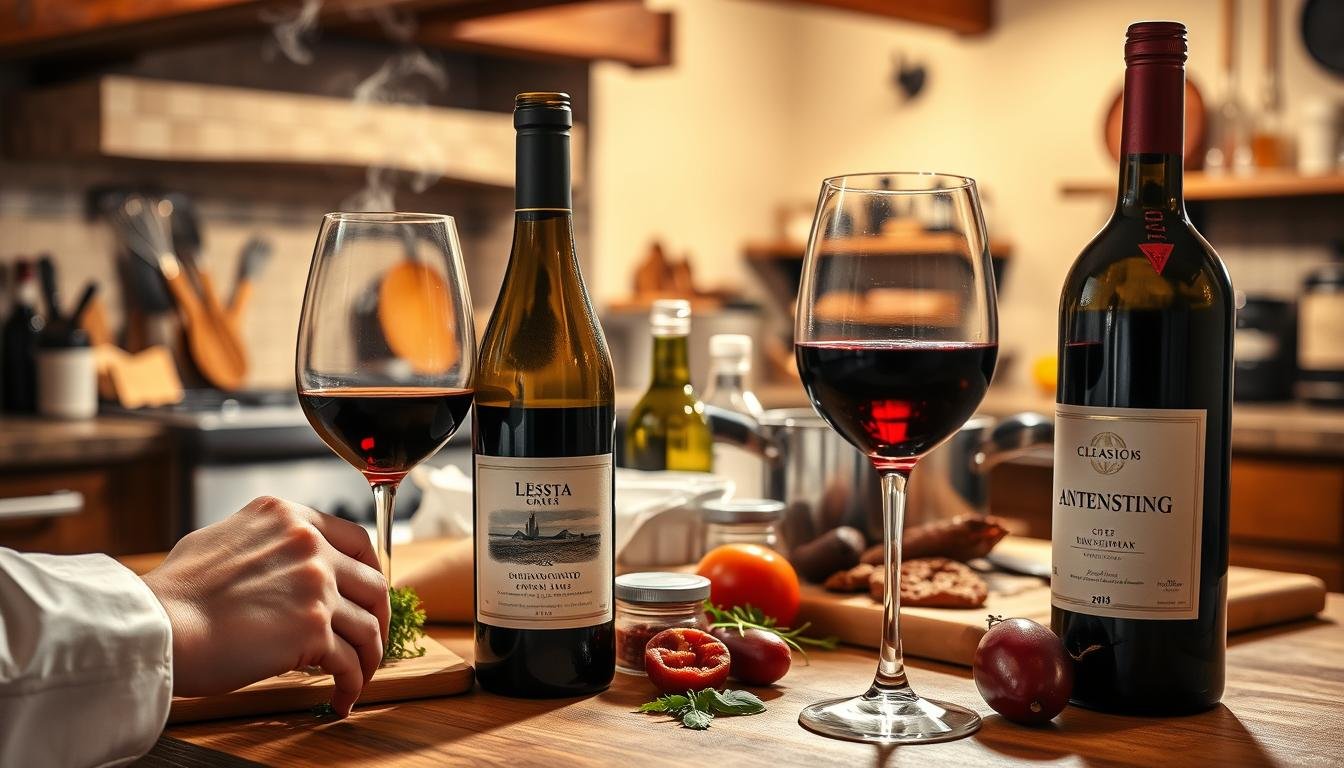Elevate your culinary creations by incorporating red wine into your recipes. This versatile ingredient adds depth, richness, and a hint of acidity to various dishes, transforming ordinary meals into extraordinary experiences.
Using wine in cooking unlocks complex flavors and aromas, making it a staple in many professional kitchens. By understanding how to harness the power of red wine, home cooks can create mouth-watering dishes that impress family and friends alike.
Key Takeaways
- Discover how to transform ordinary dishes into extraordinary culinary experiences
- Learn why red wine is a versatile ingredient that adds depth and richness to various dishes
- Understand the fundamental principles of using red wine in cooking
- Explore the chemical interactions between wine and food ingredients
- Find out how to select the right red wine for your recipes
The Magic of Red Wine in Cooking
Cooking with red wine adds a depth of flavor that is hard to achieve with other ingredients. The rich, complex taste of red wine can elevate a variety of dishes, from hearty stews to sophisticated sauces.
How Wine Transforms Your Dishes
Red wine contains several components that interact with food to create a more nuanced flavor profile. The elements in wine work together to enhance the overall dining experience.
- Wine’s tannins, acids, and alcohols interact with various food components to create a balanced taste.
- The alcohol in wine helps to release fat-soluble flavor compounds that water cannot extract.
The Science Behind Wine’s Flavor Enhancement
When you cook with red wine, several scientific processes occur that enhance the content of your dishes. The Maillard reaction, for instance, creates new flavor compounds during cooking.
| Process | Effect on Flavor |
|---|---|
| Tannins binding with proteins | Smooths the mouthfeel and reduces astringency |
| Maillard reaction | Creates new flavor compounds |
| Alcohol evaporation | Concentrates flavors |
For more information on how wine can enhance your dining experience, visit Wine Kalli.
Choosing the Right Red Wine for Cooking
Selecting the appropriate red wine for cooking can significantly impact the flavor profile of your dishes. The right wine can enhance the overall taste, while the wrong choice may lead to an unbalanced flavor.
Dry vs. Sweet Red Wines
Dry red wines are generally preferred for cooking as they provide a robust flavor without adding excessive sweetness. Sweet red wines, on the other hand, can be used in specific recipes where a hint of sweetness is desired.
Best Red Wine Varieties for Cooking
Popular dry red wine varieties for cooking include Cabernet Sauvignon, Merlot, and Syrah. These wines offer rich, complex flavors that complement a variety of dishes.
| Wine Variety | Flavor Profile | Best Used For |
|---|---|---|
| Cabernet Sauvignon | Full-bodied, tannic | Red meat dishes, rich sauces |
| Merlot | Smooth, approachable | Pasta sauces, braising liquids |
| Syrah/Shiraz | Dark fruit, spicy | Game meats, robust stews |
Why “Cooking Wine” Should Be Avoided
Cooking wine often contains added salt and preservatives, which can negatively impact the flavor of your dish. Using a high-quality, drinkable red wine is recommended instead. As a rule of thumb, “if you wouldn’t drink it, don’t cook with it.”
“The quality of the wine used in cooking directly affects the final product. Using a poor-quality wine can result in an unbalanced flavor.”
In summary, choosing the right red wine for cooking involves considering the type of wine, its flavor profile, and its quality. By selecting a suitable red wine, you can elevate your dishes and create rich, complex flavors.
Essential Techniques for Cooking with Red Wine
Mastering a few essential techniques is key to unlocking the full potential of red wine in your cooking. These methods not only enhance flavor but also tenderize and add complexity to your dishes.
Deglazing: Capturing Flavor from the Pan
Deglazing involves adding red wine to a hot pan to loosen the browned bits left after searing beef or other meats. This technique captures the rich, caramelized flavors, incorporating them into your sauce or gravy.
Reducing: Concentrating Flavors
Reducing red wine concentrates its flavors, intensifying its color and richness. By simmering the wine, you can create a thick, syrupy reduction that enhances sauces, braising liquids, and marinades, perfect for dishes featuring chicken or other poultry.
Marinating: Tenderizing and Flavoring
Marinating in red wine is an effective way to tenderize and flavor meats over time. The acidity in the wine breaks down muscle fibers, making the meat more tender and flavorful. It’s particularly effective for beef and lamb, enhancing their natural flavors when cooked with wine.
The Perfect Timing: When to Add Red Wine
The moment you add red wine to your dish can significantly impact its flavor profile. Understanding when to incorporate red wine is crucial for achieving the desired culinary outcome.
Early Addition for Long-Cooking Dishes
For long-cooking dishes, such as stews or braises, adding red wine early in the cooking process allows the flavors to meld together and intensify over time. This technique enables the wine to reduce and thicken, enhancing the overall flavor of the dish. As the dish cooks, the wine’s acidity and tannins break down, contributing to a richer, more complex taste experience.
Last-Minute Wine Additions: What to Know
Adding red wine towards the end of cooking can preserve its distinct character and brighten the dish. However, it’s essential to use this technique judiciously, as excessive wine can overpower other flavors. When adding wine near the end, use a small amount (about 1-2 tablespoons) and allow it to simmer for at least 2-3 minutes to integrate the flavors. This method works particularly well with lighter-bodied wines that won’t introduce harsh flavors to the dish.
| Technique | When to Add Wine | Effect on Dish |
|---|---|---|
| Early Addition | Beginning of cooking | Intensifies flavor over time |
| Late Addition | End of cooking | Preserves wine’s distinct character |
Red Wine Marinades and Braises
The rich flavor of red wine makes it an ideal component for marinades and braising liquids. When used correctly, it can significantly enhance the taste and tenderness of various meat dishes, particularly those involving chicken or tougher cuts of meat.
Creating the Perfect Red Wine Marinade
A well-crafted red wine marinade can tenderize and add flavor to chicken and other meats. To create an effective marinade, combine red wine with complementary ingredients like herbs, spices, and aromatics. The acidity in the wine helps break down the proteins, making the meat more tender and flavorful.
Braising Techniques with Red Wine
Braising with red wine involves partially submerging browned meat in a mixture of wine and stock, then cooking it slowly at a low temperature. This technique is particularly effective for transforming tough cuts into tender, flavorful dishes. The ideal braising liquid contains about 1 part wine to 2 parts stock, creating a balanced flavor without overwhelming acidity.
Classic Red Wine Sauces and Reductions
Elevate your culinary creations with the rich flavors of classic red wine sauces and reductions. These sauces are a fundamental component of many iconic dishes, adding depth and complexity to a variety of culinary delights.
Red Wine Reduction Basics
A good red wine reduction starts with a quality wine. Reducing wine concentrates its flavors, creating a rich and intense sauce. To achieve the perfect reduction, simply simmer the wine until it has reduced by half, stirring occasionally.
Bordelaise and Other Classic Sauces
Bordelaise sauce, made with red wine, shallots, and beef broth, is a classic example of a red wine sauce. “A good sauce can make even the simplest dish shine.” Other classic sauces include red wine reductions paired with butter and herbs for added richness.
Thickening Wine-Based Sauces
To thicken a red wine sauce, you can use a beurre manié (a mixture of butter and flour) or a cornstarch slurry. Blend the flour and butter with a fork to form a paste, then stir into the pan sauce and simmer until it thickens, 1-2 minutes. Alternatively, reducing the sauce can naturally thicken it through evaporation.
Some popular methods for thickening wine-based sauces include using beurre manié, reduction, or a cornstarch slurry. For the silkiest texture, finish the sauce with cold butter cubes whisked in off the heat. Avoid over-thickening; the sauce should coat the back of a spoon but still flow freely when poured.
Pairing Food Types with Red Wine in Cooking
The versatility of red wine in cooking allows it to be paired with a variety of food types, from meats to vegetables. This flexibility makes red wine a valuable ingredient in many recipes.
Red Meats and Game
Red wine is a classic pairing for red meats and game, as it complements their rich flavors. The tannins in the wine help to tenderize the meat, creating a more enjoyable dining experience.
Poultry and Lighter Meats
While red wine is often associated with red meat, it can also enhance the flavor of poultry and lighter meats. Using red wine in moderation can add depth to these dishes without overpowering them.
Vegetable Dishes with Red Wine
Vegetable dishes can also benefit from the addition of red wine, particularly those featuring mushrooms, onions, or root vegetables. For example, sautéing onions and mushrooms in red wine can bring out their natural sweetness and add complexity to the dish. Some key benefits include:
- Mushrooms absorbing the flavors of red wine while contributing their earthiness
- Root vegetables like beets, carrots, and onions caramelizing beautifully when cooked with red wine
- Lentils and beans becoming luxurious when simmered with red wine, herbs, and aromatics
Signature Dishes Featuring Red Wine
Incorporating red wine into recipes adds complexity and depth to the final product. This technique is used in various cuisines, particularly in French and Italian cooking.
Coq au Vin: The Classic French Dish
Coq au Vin, a traditional French recipe, braises chicken in red wine, resulting in tender meat with a rich, flavorful sauce. This dish is a quintessential example of French cuisine.
Beef Bourguignon: Rich and Savory
Beef Bourguignon is another French classic that utilizes red wine to create a hearty, savory stew. The slow-cooked beef becomes tender, and the red wine enhances the overall flavor.
Italian Classics with Red Wine
Italian cuisine also heavily features red wine in dishes like Ragù alla Bolognese, where red wine adds depth to the meat sauce, often served with pasta. For more on wine and food pairings, visit Wine Kalli’s guide.
| Dish | Cuisine | Use of Red Wine |
|---|---|---|
| Coq au Vin | French | Braising chicken in red wine |
| Beef Bourguignon | French | Creating a rich stew with red wine |
| Ragù alla Bolognese | Italian | Adding depth to meat sauce with red wine |
Common Mistakes When Cooking with Red Wine
To get the most out of red wine in your recipes, avoid these frequent mistakes. Cooking with red wine can be a great way to enhance the flavor of your dish, but certain errors can detract from the overall taste.
Using the Wrong Wine Type
Using the wrong type of red wine can significantly impact the flavor of your food. Cooking wine tends to have added salt and preservatives, which can affect the taste. Instead, use a regular red wine for a more natural flavor.
Not Cooking Off the Alcohol
Failing to cook off the alcohol can leave your dish with an unpleasant taste. As the wine reduces, its flavors concentrate, including sweetness and acidity, requiring careful taste adjustment.
Overseasoning Wine-Based Dishes
Overseasoning is another common mistake. Adding too many herbs and spices can compete with the wine’s complex flavors. Taste and adjust seasoning throughout cooking to avoid unbalanced final dishes.
Conclusion
Cooking with red wine adds a depth of flavor that transforms ordinary meals into extraordinary experiences. By choosing wines you enjoy drinking and avoiding cooking wines with added salt and preservatives, you can elevate your dishes. Mastering techniques like deglazing a pan and reducing wine properly enhances flavor. Experiment with different wine types, such as Pinot Noir and Cabernet Sauvignon, to bring unique notes to your recipes. With practice, you’ll develop an intuitive sense of how to use wine to create magnificent sauces and dishes, making it an essential ingredient in your culinary repertoire.









